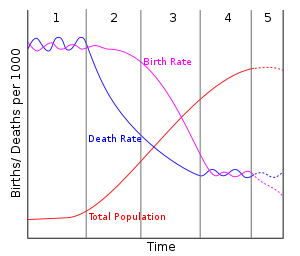
In demography and medical geography, epidemiological transition is a theory which "describes changing population patterns in terms of fertility, life expectancy, mortality, and leading causes of death."[1] For example, a phase of development marked by a sudden increase in population growth rates brought by improved food security and innovations in public health and medicine, can be followed by a re-leveling of population growth due to subsequent declines in fertility rates. Such a transition can account for the replacement of infectious diseases by chronic diseases over time due to increased life span as a result of improved health care and disease prevention.[2][3] This theory was originally posited by Abdel Omran in 1971.[4][5]
- ^ Santosa A, Wall S, Fottrell E, Högberg U, Byass P (2014). "The development and experience of epidemiological transition theory over four decades: a systematic review". Global Health Action. 7: 23574. doi:10.3402/gha.v7.23574. PMC 4038769. PMID 24848657.
- ^ Mauck, Aaron Pascal. "Managing Care: History of Diabetes in the Twentieth Century". UMI Dissertations. ProQuest 612814971.
{{cite web}}: Missing or empty|url=(help) - ^ Porta, Miquel (2014). A dictionary of epidemiology (Sixth ed.). Oxford University Press. ISBN 9780199976737.
- ^ Omran, A. R. (2005) [1971], "The epidemiological transition: A theory of the epidemiology of population change" (PDF), The Milbank Quarterly, 83 (4): 731–57, doi:10.1111/j.1468-0009.2005.00398.x, PMC 2690264, PMID 16279965, archived from the original (PDF) on 2013-04-12. Reprinted from The Milbank Memorial Fund Quarterly, 49 (4, Pt 1): 509–538, 1971
{{citation}}: CS1 maint: untitled periodical (link) - ^ Wahdan, M. H. (1996). "The epidemiological transition". Eastern Mediterranean Health Journal. 2 (1): 2.